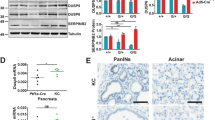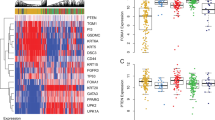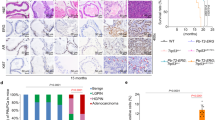Abstract
Although deregulation of the Wnt signalling pathway has been implicated in urothelial cell carcinoma (UCC), the functional significance is unknown. To test its importance, we have targeted expression of an activated form of β-catenin to the urothelium of transgenic mice using Cre–Lox technology (UroIICRE+ β-cateninexon3/+). Expression of this activated form of β-catenin led to the formation of localized hyperproliferative lesions by 3 months, which did not progress to malignancy. These lesions were characterized by a marked increase of the phosphatase and tensin homologue (PTEN) tumour suppressor protein. This appears to be a direct consequence of activating Wnt signalling in the bladder as conditional deletion of the adenomatous polyposis coli (Apc) gene within the adult bladder led rapidly to coincident β-catenin and PTEN expression. This PTEN expression blocked proliferation. Next, we combined PTEN deficiency with β-catenin activation and found that this caused papillary UCC. These tumours had increased pAKT signalling and were dependent on mammalian target of rapamycin (mTOR). Importantly, in human UCC, there was a significant correlation between high levels of β-catenin and pAKT (and low levels of PTEN). Taken together these data show that deregulated Wnt signalling has a critical role in promoting UCC, and suggests that human UCC that have high levels of Wnt and PI3 kinase signalling may be responsive to mTOR inhibition.
This is a preview of subscription content, access via your institution
Access options
Subscribe to this journal
Receive 50 print issues and online access
$259.00 per year
only $5.18 per issue
Buy this article
- Purchase on Springer Link
- Instant access to full article PDF
Prices may be subject to local taxes which are calculated during checkout






Similar content being viewed by others
References
Aveyard JS, Skilleter A, Habuchi T, Knowles MA . (1999). Somatic mutation of PTEN in bladder carcinoma. Br J Cancer 80: 904–908.
Bienz M, Clevers H . (2000). Linking colorectal cancer to Wnt signaling. Cell 103: 311–320.
Bohm M, Kirch H, Otto T, Rubben H, Wieland I . (1997). Deletion analysis at the DEL-27, APC and MTS1 loci in bladder cancer: LOH at the DEL-27 locus on 5p13-12 is a prognostic marker of tumor progression. Int J Cancer 74: 291–295.
Burger M, van der Aa MN, van Oers JM, Brinkmann A, van der Kwast TH, Steyerberg EC et al. (2008). Prediction of progression of non-muscle-invasive bladder cancer by WHO 1973 and 2004 grading and by FGFR3 mutation status: a prospective study. Eur Urol 54: 835–843.
Cordon-Cardo C . (2008). Molecular alterations associated with bladder cancer initiation and progression. Scand J Urol Nephrol Suppl 218: 154–165.
Cottrell S, Bicknell D, Kaklamanis L, Bodmer WF . (1992). Molecular analysis of APC mutations in familial adenomatous polyposis and sporadic colon carcinomas. Lancet 340: 626–630.
DeAlmeida VI, Miao L, Ernst JA, Koeppen H, Polakis P, Rubinfeld B . (2007). The soluble wnt receptor Frizzled8CRD-hFc inhibits the growth of teratocarcinomas in vivo. Cancer Res 67: 5371–5379.
Diaz DS, Segersten U, Malmstrom PU . (2008). Molecular genetics of bladder cancer: an update. Minerva Urol Nefrol 60: 205–216.
Fujishita T, Aoki K, Lane HA, Aoki M, Taketo MM . (2008). Inhibition of the mTORC1 pathway suppresses intestinal polyp formation and reduces mortality in ApcDelta716 mice. Proc Natl Acad Sci USA 105: 13544–13549.
Garcia dMX, Torregrosa A, Munoz J, Castellsague X, Condom E, Vigues F et al. (2000). Prognostic value of the expression of E-cadherin and beta-catenin in bladder cancer. Eur J Cancer 36: 357–362.
Harada N, Tamai Y, Ishikawa T, Sauer B, Takaku K, Oshima M et al. (1999). Intestinal polyposis in mice with a dominant stable mutation of the beta-catenin gene. EMBO J 18: 5931–5942.
He F, Mo L, Zheng XY, Hu C, Lepor H, Lee EY et al. (2009). Deficiency of pRb family proteins and p53 in invasive urothelial tumorigenesis. Cancer Res 69: 9413–9421.
He TC, Sparks AB, Rago C, Hermeking H, Zawel L, da Costa LT et al. (1998). Identification of c-MYC as a target of the APC pathway. Science 281: 1509–1512.
Howe LR, Brown AM . (2004). Wnt signaling and breast cancer. Cancer Biol Ther 3: 36–41.
Ireland H, Kemp R, Houghton C, Howard L, Clarke AR, Sansom OJ et al. (2004). Inducible Cre-mediated control of gene expression in the murine gastrointestinal tract: effect of loss of beta-catenin. Gastroenterology 126: 1236–1246.
Kashibuchi K, Tomita K, Schalken JA, Kume H, Yamaguchi T, Muto S et al. (2006). The prognostic value of E-cadherin, alpha-, beta-, and gamma-catenin in urothelial cancer of the upper urinary tract. Eur Urol 49: 839–845.
Kastritis E, Murray S, Kyriakou F, Horti M, Tamvakis N, Kavantzas N et al. (2009). Somatic mutations of adenomatous polyposis coli gene and nuclear β-catenin accumulation have prognostic significance in invasive urothelial carcinomas: evidence for Wnt pathway implication. Int J Cancer 124: 103–108.
Kemp R, Ireland H, Clayton E, Houghton C, Howard L, Winton DJ . (2004). Elimination of background recombination: somatic induction of Cre by combined transcriptional regulation and hormone binding affinity. Nucleic Acids Res 32: e92.
Kinzler KW, Nilbert MC, Su LK, Vogelstein B, Bryan TM, Levy DB et al. (1991). Identification of FAP locus genes from chromosome 5q21. Science 253: 661–665.
Kirkegaard T, Edwards J, Tovey S, McGlynn LM, Krishna SN, Mukherjee R et al. (2006). Observer variation in immunohistochemical analysis of protein expression, time for a change? Histopathology 48: 787–794.
Lesche R, Groszer M, Gao J, Wang Y, Messing A, Sun H et al. (2002). Cre/loxP-mediated inactivation of the murine Pten tumor suppressor gene. Genesis 32: 148–149.
Luis NM, Lopez-Knowles E, Real FX . (2007). Molecular biology of bladder cancer. Clin Transl Oncol 9: 5–12.
MacAulay K, Doble BW, Patel S, Hansotia T, Sinclair EM, Drucker DJ et al. (2007). Glycogen synthase kinase 3alpha-specific regulation of murine hepatic glycogen metabolism. Cell Metab 6: 329–337.
Marsh V, Winton DJ, Williams GT, Dubois N, Trumpp A, Sansom OJ et al. (2008). Epithelial Pten is dispensable for intestinal homeostasis but suppresses adenoma development and progression after Apc mutation. Nat Genet 40: 1436–1444.
Marsit CJ, Karagas MR, Andrew A, Liu M, Danaee H, Schned AR et al. (2005). Epigenetic inactivation of SFRP genes and TP53 alteration act jointly as markers of invasive bladder cancer. Cancer Res 65: 7081–7085.
McManus EJ, Sakamoto K, Armit LJ, Ronaldson L, Shpiro N, Marquez R et al. (2005). Role that phosphorylation of GSK3 plays in insulin and Wnt signalling defined by knockin analysis. EMBO J 24: 1571–1583.
Miyamoto H, Shuin T, Ikeda I, Hosaka M, Kubota Y . (1996). Loss of heterozygosity at the p53, RB, DCC and APC tumor suppressor gene loci in human bladder cancer. J Urol 155: 1444–1447.
Mo L, Cheng J, Lee EY, Sun TT, Wu XR . (2005). Gene deletion in urothelium by specific expression of Cre recombinase. Am J Physiol Renal Physiol 289: F562–F568.
Mo L, Zheng X, Huang HY, Shapiro E, Lepor H, Cordon-Cardo C et al. (2007). Hyperactivation of Ha-ras oncogene, but not Ink4a/Arf deficiency, triggers bladder tumorigenesis. J Clin Invest 117: 314–325.
Moon RT, Kohn AD, De Ferrari GV, Kaykas A . (2004). WNT and beta-catenin signalling: diseases and therapies. Nat Rev Genet 5: 691–701.
Nagayama S, Fukukawa C, Katagiri T, Okamoto T, Aoyama T, Oyaizu N et al. (2005). Therapeutic potential of antibodies against FZD 10, a cell-surface protein, for synovial sarcomas. Oncogene 24: 6201–6212.
Nakopoulou L, Zervas A, Gakiopoulou-Givalou H, Constantinides C, Doumanis G, Davaris P et al. (2000). Prognostic value of E-cadherin, beta-catenin, P120ctn in patients with transitional cell bladder cancer. Anticancer Res 20: 4571–4578.
Namba R, Young LJ, Abbey CK, Kim L, Damonte P, Borowsky AD et al. (2006). Rapamycin inhibits growth of premalignant and malignant mammary lesions in a mouse model of ductal carcinoma in situ. Clin Cancer Res 12: 2613–2621.
Ng SS, Mahmoudi T, Danenberg E, Bejaoui I, de Lau W, Korswagen HC et al. (2009). Phosphatidylinositol 3-kinase signaling does not activate the wnt cascade. J Biol Chem 284: 35308–35313.
Novak A, Guo C, Yang W, Nagy A, Lobe CG . (2000). Z/EG, a double reporter mouse line that expresses enhanced green fluorescent protein upon Cre-mediated excision. Genesis 28: 147–155.
Parkin DM, Bray F, Ferlay J, Pisani P . (2005). Global cancer statistics, 2002. CA Cancer J Clin 55: 74–108.
Patel S, Doble BW, MacAulay K, Sinclair EM, Drucker DJ, Woodgett JR . (2008). Tissue-specific role of glycogen synthase kinase 3beta in glucose homeostasis and insulin action. Mol Cell Biol 28: 6314–6328.
Polakis P . (2000). Wnt signaling and cancer. Genes Dev 14: 1837–1851.
Puzio-Kuter AM, Castillo-Martin M, Kinkade CW, Wang X, Shen TH, Matos T et al. (2009). Inactivation of p53 and Pten promotes invasive bladder cancer. Genes Dev 23: 675–680.
Rubinfeld B, Souza B, Albert I, Muller O, Chamberlain SH, Masiarz FR et al. (1993). Association of the APC gene product with beta-catenin. Science 262: 1731–1734.
Salmena L, Carracedo A, Pandolfi PP . (2008). Tenets of PTEN tumor suppression. Cell 133: 403–414.
Schulz WA . (2006). Understanding urothelial carcinoma through cancer pathways. Int J Cancer 119: 1513–1518.
Shibata H, Toyama K, Shioya H, Ito M, Hirota M, Hasegawa S et al. (1997). Rapid colorectal adenoma formation initiated by conditional targeting of the Apc gene. Science 278: 120–123.
Shiina H, Igawa M, Shigeno K, Terashima M, Deguchi M, Yamanaka M et al. (2002). Beta-catenin mutations correlate with over expression of C-myc and cyclin D1 Genes in bladder cancer. J Urol 168: 2220–2226.
Shiina H, Igawa M, Urakami S, Shigeno K, Yoneda T, Terashima M et al. (2001). Alterations of beta- and gamma-catenin in N-butyl-N-(-4-hydroxybutyl) nitrosamine-induced murine bladder cancer. Cancer Res 61: 7101–7109.
Shimazui T, Schalken JA, Giroldi LA, Jansen CF, Akaza H, Koiso K et al. (1996). Prognostic value of cadherin-associated molecules (alpha-, beta-, and gamma-catenins and p120cas) in bladder tumors. Cancer Res 56: 4154–4158.
Stoehr R, Krieg RC, Knuechel R, Hofstaedter F, Pilarsky C, Zaak D et al. (2002). No evidence for involvement of beta-catenin and APC in urothelial carcinomas. Int J Oncol 20: 905–911.
Teng DH, Hu R, Lin H, Davis T, Iliev D, Frye C et al. (1997). MMAC1/PTEN mutations in primary tumor specimens and tumor cell lines. Cancer Res 57: 5221–5225.
Tetsu O, McCormick F . (1999). Beta-catenin regulates expression of cyclin D1 in colon carcinoma cells. Nature 398: 422–426.
Tsuruta H, Kishimoto H, Sasaki T, Horie Y, Natsui M, Shibata Y et al. (2006). Hyperplasia and carcinomas in Pten-deficient mice and reduced PTEN protein in human bladder cancer patients. Cancer Res 66: 8389–8396.
Urakami S, Shiina H, Enokida H, Kawakami T, Kawamoto K, Hirata H et al. (2006a). Combination analysis of hypermethylated Wnt-antagonist family genes as a novel epigenetic biomarker panel for bladder cancer detection. Clin Cancer Res 12: 2109–2116.
Urakami S, Shiina H, Enokida H, Kawakami T, Tokizane T, Ogishima T et al. (2006b). Epigenetic inactivation of Wnt inhibitory factor-1 plays an important role in bladder cancer through aberrant canonical Wnt/beta-catenin signaling pathway. Clin Cancer Res 12: 383–391.
Wu XR . (2005). Urothelial tumorigenesis: a tale of divergent pathways. Nat Rev Cancer 5: 713–725.
Yoo LI, Liu DW, Le Vu S, Bronson RT, Wu H, Yuan J . (2006). Pten deficiency activates distinct downstream signaling pathways in a tissue-specific manner. Cancer Res 66: 1929–1939.
You L, He B, Xu Z, Uematsu K, Mazieres J, Fujii N et al. (2004). An anti-Wnt-2 monoclonal antibody induces apoptosis in malignant melanoma cells and inhibits tumor growth. Cancer Res 64: 5385–5389.
Zhang ZT, Pak J, Huang HY, Shapiro E, Sun TT, Pellicer A et al. (2001). Role of Ha-ras activation in superficial papillary pathway of urothelial tumor formation. Oncogene 20: 1973–1980.
Zhang ZT, Pak J, Shapiro E, Sun TT, Wu XR . (1999). Urothelium-specific expression of an oncogene in transgenic mice induced the formation of carcinoma in situ and invasive transitional cell carcinoma. Cancer Res 59: 3512–3517.
Zhu X, Kanai Y, Saito A, Kondo Y, Hirohashi S . (2000). Aberrant expression of beta-catenin and mutation of exon 3 of the beta-catenin gene in renal and urothelial carcinomas. Pathol Int 50: 945–952.
Acknowledgements
This work was funded by Cancer Research UK and a MRC fellowship to Imran Ahmad and AICR grant to Sorina Radulescu. We thank BICR services, biological services unit, and Colin Nixon and his histology department. We also thank the ‘Think Pink’ charity for the purchase of the Aperio slide scanner and the Slidepath software.
Author information
Authors and Affiliations
Corresponding author
Ethics declarations
Competing interests
The authors declare no conflict of interest.
Additional information
Supplementary Information accompanies the paper on the Oncogene website
Supplementary information
Rights and permissions
About this article
Cite this article
Ahmad, I., Morton, J., Singh, L. et al. β-Catenin activation synergizes with PTEN loss to cause bladder cancer formation. Oncogene 30, 178–189 (2011). https://doi.org/10.1038/onc.2010.399
Received:
Revised:
Accepted:
Published:
Issue Date:
DOI: https://doi.org/10.1038/onc.2010.399
Keywords
This article is cited by
-
Downregulated exosomal microRNA-148b-3p in cancer associated fibroblasts enhance chemosensitivity of bladder cancer cells by downregulating the Wnt/β-catenin pathway and upregulating PTEN
Cellular Oncology (2021)
-
Intensity of Nuclear Staining for Ki-67, p53 and Survivin as a New Prognostic Factor in Non-muscle Invasive Bladder Cancer
Pathology & Oncology Research (2020)
-
PPARγ activation serves as therapeutic strategy against bladder cancer via inhibiting PI3K-Akt signaling pathway
BMC Cancer (2019)
-
Urothelial organoids originating from Cd49fhigh mouse stem cells display Notch-dependent differentiation capacity
Nature Communications (2019)
-
Expression of Glypican 3 in low and high grade urothelial carcinomas
Diagnostic Pathology (2015)



